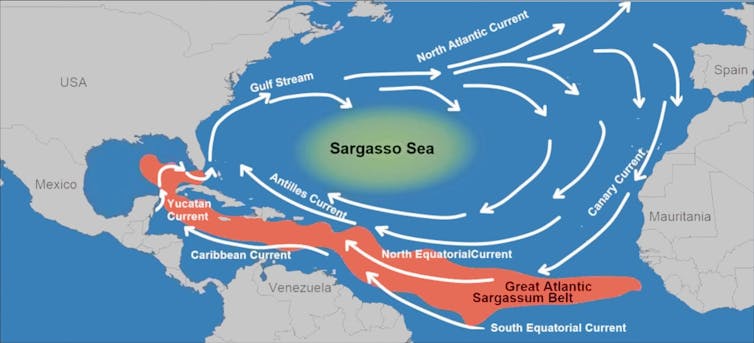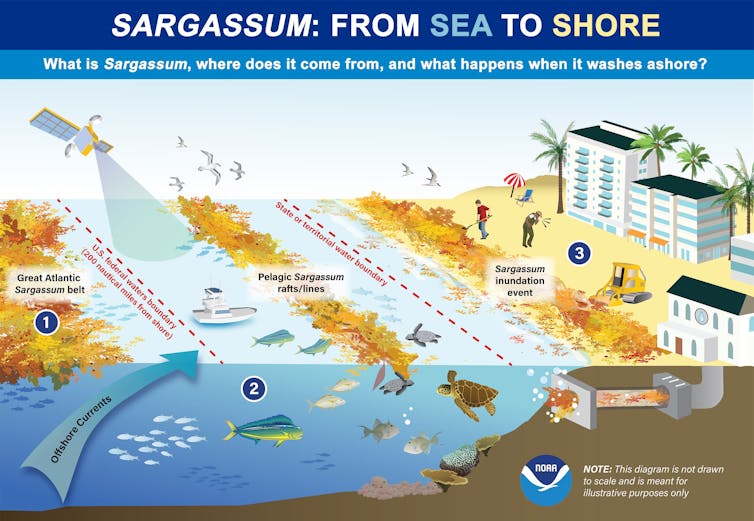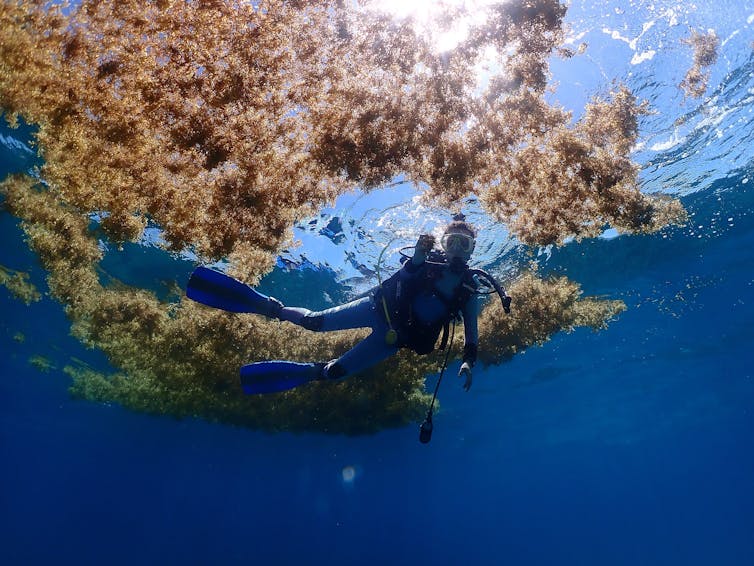The Caribbean’s sandy beaches, clear turquoise water and vibrant coral reefs filled with an amazing variety of sea creatures have long been the pride of the islands.
The big three – sun, sea and sand – have made this tropical paradise the most tourism-reliant region in the world.
But now, all of that is under threat. The explosive growth of a type of seaweed called sargassum is wreaking havoc on economies, coastal environments and human health across the islands.
I study the intersection of critical infrastructure and disasters, particularly in the Caribbean. The sargassum invasion has worsened since it exploded in the region in 2011. Forecasts and the seaweed already washing up suggest that 2024 will be another alarming year.

The Sargasso Sea
The Sargasso Sea is often referred to as a golden, floating rainforest for its vast floating sargassum blooms and the wide variety of sea life that it supports.
It is the only sea in the world with no land borders. Instead, it is bounded by four Atlantic Ocean currents: the North Atlantic current, the Gulf Stream, the North Atlantic Equatorial Current and the Canary Current.

Without human interference, and under normal conditions, sargassum is a good thing. It has existed in the Caribbean for centuries, providing habitat and food for ocean wildlife, including threatened and endangered species such as the porbeagle shark and the anguillid eel.
Conditions over the past decade around the Caribbean Sea, North Atlantic and Gulf of Mexico, however, have been anything but normal.
Since 2011, vast mats of sargassum seaweed have been washing up on Caribbean islands. On shore, they pile up into a dead and stinky mass.

These sargassum events have been occurring more frequently and are lasting longer, and the amount of algae is increasing.
The situation has gotten so bad that NOAA created a weekly sargassum inundation risk index in collaboration with the University of South Florida. They have predicted that 2024 will be another terrible year for the Caribbean.
Pollution fuels a hazardous algae bloom
So, what is causing the explosive growth of this algae? Studies have pointed to pollution that the Caribbean region itself has done little to contribute to.
Humans are altering the nutrient cycle by releasing fertilizer runoff and industrial wastewater into rivers, which sends phosphates and nitrates down river systems and out into the oceans. These are key nutrients for plant growth.

A rapid increase in ranching, logging and agriculture along the Amazon River in South America is one source, sending huge amounts of nutrients washing into the river, which terminates in the Caribbean Sea.
Another culprit is the Mississippi River, which carries nutrient-rich effluent from farms and industries into the Gulf of Mexico.
The Congo River in Africa also carries pollutants into the ocean from deforestation, and burning forests can deliver nutrients, such as nitrogen, phosphorus and iron, that further fuel algae growth.
These pollutants are swept up by ocean currents. An increase in phosphate and nitrogen water pollution, combined with warming waters, is believed to have supercharged seaweed normally carried by currents from the Sargasso Sea and created the sargassum belt, which persists across the Caribbean today.
Coasts, fishing industries can’t escape the harm
In small quantities, sargassum plays a role in beach nourishment. But when it inundates coastlines, the rotting seaweed smothers beaches and reduces the amount of oxygen in the water, killing fish and harming fragile coral reefs.

The massive influx of sargassum has also disrupted fishing operations. Fishers find themselves struggling to maintain their livelihoods as sargassum is diminishing their catch. The seaweed has damaged fishing gear and boat engines and blocked access to harbors and mooring sites.
In addition, sargassum can concentrate arsenic, which poses the risk of contaminating fish and harming people who may eat them.
Sargassum on land is a public health threat
Sargassum rots quickly when stranded. Within 48 hours, it begins to degrade, releasing hydrogen sulphide and ammonia. At certain concentrations, these gases become not only toxic to the marine environment but also to human health.
There have been a growing number of reported cases of neurological, digestive and respiratory disorders associated with the noxious gases being emitted. Guadeloupe’s air-quality monitoring institute Gwad’Air has issued red alerts in recent years because of dangerous levels of hydrogen sulfide gas being emitted from rotting sargassum.
The most common symptoms experienced by people living within close proximity to sargassum are headache, dizziness, abdominal pain, cough, rashes, eye disorders and effects on mood. Sargassum odors have led to an increase in nausea and headaches among school-age children. Pregnant women in the region are also being affected, with increasing reported cases of preeclampsia.
Sargassum has also clogged water intake tubes for desalination plants and power plants that use seawater for cooling, causing these units to shut down.
In the British Virgin Islands, sargassum sucked into the main desalination plant in 2023 led to smelly tap water and sporadic water shut-offs. In Virgin Gorda and St. Croix, people have reported smells, a burning sensation and skin rashes from their tap water.
Sargassum blooms also damage economies
Millions of tons of dead and rotting seaweed washing ashore can have widespread economic consequences.
The odor of the rotting seaweed attracts insects, which has been a repellent for some tourists. Cleaning the beaches and disposing of tons of debris, typically in landfills, cost the Caribbean about US$120 million in 2018.
That doesn’t include the economic losses for hotels, fisheries and other businesses.
Small businesses such as Jet Ski rentals that depend on the coast for revenue generation have at times been forced to shut down because of the odorous gases released from the decaying mass.
Is there a solution?
Research and entrepreneurial initiatives are underway to try to deal with the seaweed. Companies have tried turning it into fertilizer, cattle feed and concrete, but so far only at small scale.
Governments have made little progress beyond agreeing to some fisheries management rules to protect vulnerable species. A few countries have draft management strategies, but action is typically focused on protecting the tourism industry, with little attention given to fisherfolk and local communities.
The sargassum invasion is fueled by global pollution, and fixing that requires a global response.
The United Nations Environment Program has called for increased international cooperation to understand the causes and impact of sargassum invasions and to find ways to help the countries affected. But so far, the international community has done little to address the pollution at the root of the problem.

